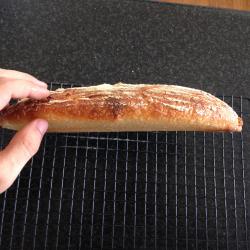
Hello everyone,
I'm having trouble with my sourdough batard lately. It is very difficult to handle and shape because it is so sticky, and when it goes into the oven, it ends up flat... virtually like a pancake. It tastes lovely, though.
I'm not sure what I'm doing wrong - I would really appreciate any assistance!
I use the following recipe:
- 320mL tepid water (about body temperature)
- 500g flour
- 13g granular sea salt
- 200g white starter @ 100% hydration
My method is as follows:
I use a KitchenAid mixer to prepare the dough. My starter is given three feeds spaced at 12 hours apart, starting at 50g and ending at 150g of flour and water, at 100% hydration.
The starter is dissolved in the tepid water before I add in the flour. I mix at first speed for 4 minutes, then second speed for 2 minutes. Followed by 30 minute autolyse, I mix again at second speed for 3 minutes.
Bulk proof 3 hours at 26 degrees in an oiled bowl, placed in Brod and Taylor proofing box. Stretch and fold after 1.5 hours.
Divide into 750g loaf (to fit my banneton), preshape and rest 20 minutes. Final shape and put into floured banneton.
Retard in fridge for 12-16 hours. Defrost for 3 hours. Score the loaf, put onto baking sheet and bake at 250 for 15 minutes with steam, followed by 200 for another 15 minutes.

Replies
Hello celestialrose,
The main thing that I can think of is that the dough is over proved/developed. I would be thinking of reducing the intensity (and duration) of your mixing. My recollection is that Kitchenaid only recommend using 1 or 2 for dough mixing and perhaps cut back to only a few minutes. Maybe also reduce the time in the fridge and also maybe only an hour out of the fridge while you heat your oven before baking.
You could even consider by-passing the proofing box stage given that the dough should be well developed after the mixing stage and the retardation phase could easily be enough for what you want.
Good luck with your projects.
Farinam
Thank you very much for your advice, it has been extremely helpful in getting a better loaf.
Sadly, my loaves appear to be splitting at the sides and on the bottom. Could you please advise on a likely cause?
Jumping back a little, it would appear that perhaps your loaves are too small for the banneton?
How can you get two 750gm loaves when your ingredients only add up to 1033gm? Try a 500gm banneton.
Hi Reuven, thanks for your response.
My post had a typo and poor syntax. There is only one loaf being made, and placed into a 750g banneton.
Hello celestialrose,
When the loaf rises it will split at a point of weakness which, ideally, should be the slash(es) that you put in the loaf before it goes into the oven.
Splits at other places can be due to flaws in the continuity of the 'skin' created during the shaping of the loaf which might be due to tears caused by over tensioning, overlaps and seams not properly sealed (often caused by excess flour dusting) and so forth.
Another cause can be due to drying of the skin, either during proving or in the early stages of baking which restricts the expansion of the loaf and causes high stress and bursting at 'sharp' changes in shape such as at the transition from the base to the sides so bursting at the bottom edge is a common symptom of this type. That is one of the ideas behind using steam in the early part of baking, to keep the crust soft until the rapid expansion is complete. Also for a humid environment during proving.
If the loaf is not bursting preferentially along your slashes, it suggests that perhaps they are not being executed properly. Ideally, the slashes should be under-cut with the blade at a low angle to the surface of the loaf and be reasonably deep without being too deep. Something like 10-15mm would be in order. Often with a batarde, the practice is to slash more or less down the centre-line of the loaf at a slight angle traversing the centre-line. This gives a nice symmetrical rise up the centre-line without affecting the length of the loaf. The more transverse the slashing, the more the expansion is longitudinal.
Good luck with your projects.
Farinam